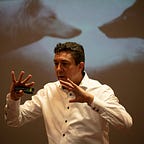Enhancing team performance
The traditional way to improve team performance is to focus on the individual. For example, by making an individual team member aware of his or her dominant style of thinking, acting and communicating, and by making clear what effect this has on the collaboration within the team. Various instruments or models are available to achieve this, such as the team roles of Belbin, MBTI, Insights or Management Drives. The next step is to train the individual to make the best use of his or her talents and to communicate more effectively with the other team members. Which leads to changes in the way the individual interacts and cooperates within the team, and to an improvement in team results. In other words: change the way the individual thinks and acts and the team will develop as a whole.
You could expand this so that everyone within the team becomes aware of their own way of thinking, acting and communicating. If you then share this new information among the other team members, allowing them to understand each other better, enabling them to make use of each other’s strong points, and make agreements about how to communicate with each other, the results of the team will be enhanced even further. This is a terrific achievement of course, but it remains a traditional method of team development.
Or what about this variant: if two team members can’t get along with each other and this is affecting the atmosphere within the whole team, you try to work on their relationship. Improving their relationship will have a direct impact on the atmosphere and results of the whole team. And then the ideal variant: if it turns out that someone “doesn’t fit in the team” then we replace that person with a “more suitable” team member. Just as with an engine: if the broken part can’t be repaired, we just replace it.
To summarise then, we could say that within the traditional approach to team development the general points of departure are: changes to parts of the team have an effect on the whole team. It’s a perfectly legitimate way of influencing the team and I would like to present you here with a new, more powerful method available to achieve this.
The new method of team development is based on the system approach. This means that we acknowledge that people have an influence on other team members, but we also assume that the ‘culture’ of the team has an even stronger influence on the individual. You’ve probably experienced this yourself when you were part of a team with a low or even hostile morale, or a team that you felt could take on the world. Think back to the time you were a member of such a team; try and recall why the atmosphere was so good or bad, and how it influenced performance and your way of thinking, acting and communicating. And then watch this film to see how destructive the atmosphere within a team can be.
The essence of this new method of team development lies in acknowledging the fact that the culture a team engenders has an enormous influence on the individual team members and their interaction — and consequently also their performance. Which is why we can say: change the team culture and the results achieved by the team will change with it (both positively and negatively). If we can change the culture to such an extent that, amongst other things, there is sufficient mutual trust and respect, and that diversity is valued, then as well as developing the culture further, we can ‘zoom in’ on the individual qualities. And that’s when we can also start making use of the techniques offered by traditional development methods.
Team development based on the system approach consists of six major principles.
- Reveal the system to itself. By holding up a mirror of the prevailing culture to the team members, they can choose the direction they want to go in.
- Specify the team’s energetic field. In other words, give a name to that ‘something’ that cannot be expressed in words, but that is present in the ‘space’.
- Specify and develop diversity. This concerns appreciating and accepting everyone’s opinion and way of thinking: ‘everyone is right, but partially’.
- Listen to the rising undercurrent. This is a special variant of specifying the energetic level. It entails specifying the direction in which the team as a whole is developing.
- Intensify co-responsibility. Each team member is responsible for his or her own tasks. But they all have the responsibility for accomplishing the mission of the team. This takes precedent over the individual responsibility.
- Enhance positivity, reduce negativity. Instead of stressing what needs to be improved, much attention is paid to what is already functioning well and how this can be further enhanced.
Your challenge this time is to take a good look at your team in the next few weeks, focussing on these six principles. Consider which aspect you would like to develop further, and… go for it! If you need some support, feel free contact me. We could then start your development trajectory by taking a ‘snapshot’ of the current state of affairs using the Team Diagnostic Assessment™ of Team Coaching International. The power of this tool lies in the fact that the snapshot that is taken says nothing about whether the culture is good or bad, and that the information is extremely simple and intuitive to follow. All it produces is information, based on which team members can identify for themselves what the culture is and how it is influencing their thinking and acting. If you’re interested, I can send you a sample report.
Enjoy enhancing your team’s performance!
Marco Buschman
marco@courius.com
Want to learn how to become a truely connected human being, as well as how to become a connected manager? Read my latest book THE CONNECTION QUOTIENT which is available at your local Amazon webpage .
